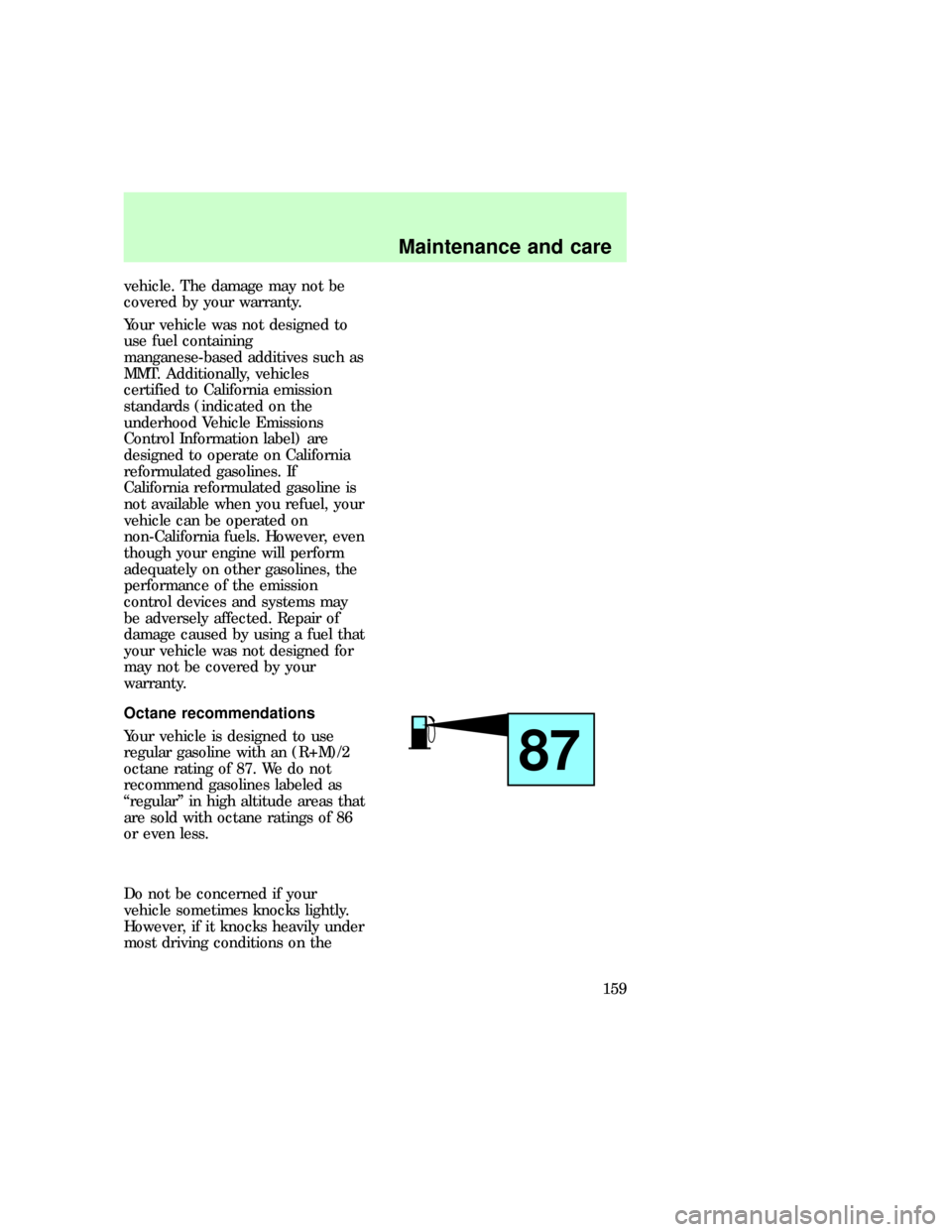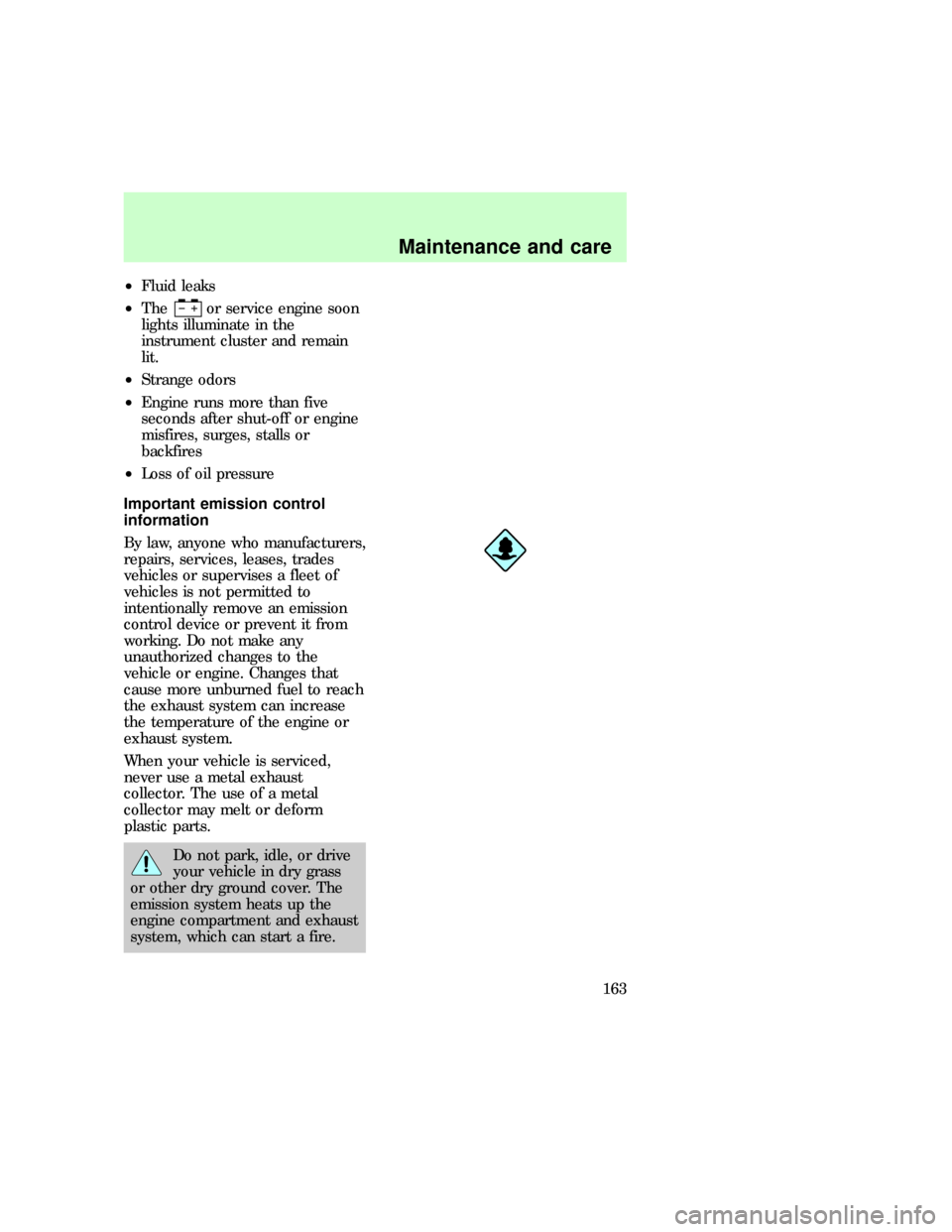Page 145 of 192

Servicing your battery
The low-maintenance battery has
removable vent caps for checking
the electrolyte level and adding
water. Check the electrolyte level
every 24 months or 40,000 km
(24,000 miles) in average
temperatures below 32ÉC (90ÉF).
Keep the electrolyte level in each
cell up to the level indicator. Do
not overfill.
If the level gets low, refill the
battery with distilled water. If the
battery needs water quite often,
have the charging system checked
for a possible malfunction.
Relearning idle conditions
Because your vehicle's engine is
electronically controlled by a
computer, some control conditions
are maintained by power from the
battery. When the battery is
disconnected or a new battery is
installed, the computer must
ªrelearnº its idle conditions before
your vehicle will drive properly. To
complete this process:
1. Put the gearshift in P (Park).
2. Turn off all accessories, and
start the engine.
3. Let the engine idle for at least
one minute.
DPRN 21
Maintenance and care
145
Page 146 of 192
4. The relearning process will
automatically complete as you
drive the vehicle.
²If you do not allow the engine to
relearn its idle, the idle quality
of your vehicle may be adversely
affected until the idle is
eventually relearned.
²If the battery has been
disconnected or a new battery
has been installed, the clock and
preset radio stations must be
reset once the battery is
reconnected.
²Always dispose of used
automotive batteries in a
responsible manner. Follow your
community's standards for
disposal. Call your local
recycling center to find out
more about recycling automotive
batteries.
Disconnecting dual batteries (if
equipped)
Gasoline engines
Disconnect:
eco_battery_disconnect
eco_battery_gas_disconnect
Maintenance and care
146
Page 148 of 192
Diesel engines
Disconnect:
Secondary positive cable
remains energized after
disconnection. make sure the
tool does not contact any ground
surface.
1. Disconnect the secondary
positive cable from the primary
battery terminal.
2. Wrap the secondary positive
cable with a non-conductive
material to insulate.
3. Disconnect the primary battery
ground cable.
4. Disconnect the primary battery
positive cable.
Maintenance and care
148
Page 159 of 192

vehicle. The damage may not be
covered by your warranty.
Your vehicle was not designed to
use fuel containing
manganese-based additives such as
MMT. Additionally, vehicles
certified to California emission
standards (indicated on the
underhood Vehicle Emissions
Control Information label) are
designed to operate on California
reformulated gasolines. If
California reformulated gasoline is
not available when you refuel, your
vehicle can be operated on
non-California fuels. However, even
though your engine will perform
adequately on other gasolines, the
performance of the emission
control devices and systems may
be adversely affected. Repair of
damage caused by using a fuel that
your vehicle was not designed for
may not be covered by your
warranty.
Octane recommendations
Your vehicle is designed to use
regular gasoline with an (R+M)/2
octane rating of 87. We do not
recommend gasolines labeled as
ªregularº in high altitude areas that
are sold with octane ratings of 86
or even less.
Do not be concerned if your
vehicle sometimes knocks lightly.
However, if it knocks heavily under
most driving conditions on the
87
com_octane_recommendations.01
Maintenance and care
159
Page 160 of 192

recommended octane fuel, see
your dealer or a qualified service
technician to prevent any engine
damage.
Fuel quality
If you are experiencing starting,
rough idle or hesitation problems
try a different brand of fuel. If the
condition persists, see your dealer
or a qualified service technician.
The American Automobile
Manufacturers Association (AAMA)
issued a gasoline specification to
provide information on high quality
fuels that optimize the
performance of your vehicle. We
recommend the use of gasolines
that meet the AAMA specification
if they are available.
It should not be necessary to add
any aftermarket products to your
fuel tank if you continue to use a
high-quality fuel.
Cleaner air
Ford approves the use of gasolines
to improve air quality, including
reformulated gasolines, that
contain oxygenates such as a
maximum of 10% ethanol or 15%
MTBE. There should be no more
than 5% methanol with cosolvents
and additives to protect the fuel
system.
Calculating fuel economy
To accurately calculate your
vehicle's fuel economy:
com_fuel_quality.01
com_cleaner_air.01
com_calculating_economy.01
Maintenance and care
160
Page 161 of 192

1. Fill the tank completely and
record the initial odometer
reading.
2. Each time you fill the tank,
record the amount of fuel added
(in liters or gallons).
3. After at least three to five fuel
tank fill-ups, fill the fuel tank and
record the current mileage
reading.
4. Use one of the following
equations to calculate fuel
economy.
Liters used x 1004Total
kilometers traveled
Total miles traveled4Total
gallons used
Keep a record for at least one
month. This will provide an
accurate estimate of the vehicle's
fuel economy.
WHAT YOU SHOULD KNOW
ABOUT THE EMISSION
CONTROL SYSTEM
Your vehicle is equipped with a
catalytic convertor which enables
your vehicle to comply with
applicable exhaust emission
requirements. For more
information on your vehicle's
emission control system, see the
Vehicle Emission Control
Information decal located on the
left side of the engine
compartment.
Follow these guidelines to ensure
proper emission system operation:
eco_emission_control
Maintenance and care
161
Page 162 of 192
²Use only unleaded fuel.
²Avoid running out of fuel.
²Do not turn off the ignition
while the vehicle is in motion.
²Have regular maintenance
checks performed according to
the intervals in theService
Guide.
When servicing your vehicle, never
use a metal exhaust collector. A
metal collector may melt or deform
plastic parts.
Do not park, idle, or drive
your vehicle in dry grass
or other dry ground cover. The
emission system heats up the
engine compartment and exhaust
system, which can start a fire.
If you smell exhaust fumes
inside your vehicle, have
your dealer inspect your vehicle
immediately. Do not drive if you
smell exhaust fumes.
On vehicles without
original equipment floor
covering or insulation, do not let
passengers ride in your truck in
a manner that allows contact
between skin and the metal floor.
If you notice one or more of the
following, the emissions system
may not be working properly. Have
your vehicle serviced as soon as
possible.
Maintenance and care
162
Page 163 of 192

²Fluid leaks
²The
or service engine soon
lights illuminate in the
instrument cluster and remain
lit.
²Strange odors
²Engine runs more than five
seconds after shut-off or engine
misfires, surges, stalls or
backfires
²Loss of oil pressure
Important emission control
information
By law, anyone who manufacturers,
repairs, services, leases, trades
vehicles or supervises a fleet of
vehicles is not permitted to
intentionally remove an emission
control device or prevent it from
working. Do not make any
unauthorized changes to the
vehicle or engine. Changes that
cause more unburned fuel to reach
the exhaust system can increase
the temperature of the engine or
exhaust system.
When your vehicle is serviced,
never use a metal exhaust
collector. The use of a metal
collector may melt or deform
plastic parts.
Do not park, idle, or drive
your vehicle in dry grass
or other dry ground cover. The
emission system heats up the
engine compartment and exhaust
system, which can start a fire.
eco_emission_info
eco_i-m_testing
Maintenance and care
163